ANSI/TIA-568-C testing LC to SC (Duplex Multimode) DTX-MFM2
Hinweis: If you are being asked for an Encircled Flux compliant test, please click here.
Never use bend insensitive multimode fiber for test reference cords. Your 850 nm reading will be pessimistic.
This article will describe the steps required to successfully certify a multimode LC to SC duplex fiber link in accordance with ANSI/TIA-568-C using the DTX-MFM2 fiber adapters. ANSI/TIA-568-C requires the user to follow Method B (also known as 1 Jumper) which ensures that the connectors at each end of the link are measured and negative loss readings are avoided.
Items required in addition to a DTX CableAnalyzer:
Reinigung ist äußerst wichtig. It is the single most reason for ending up with negative loss values. You cannot clean without some means of visually inspecting the end face. This can be anything from a simple Fiber Viewer to a Video Scope such as the FiberInspector Mini shown above. If you have no inspection device, you cannot proceed. Let's define what is acceptable and not acceptable.
The Test Reference Cords (TRCs) are critical to a successful measurement. Your multimode TRCs loss should not exceed 0,10 dB at each end. And yes, you must inspect and clean these TRCs every time you use them - even new ones out of the bag.
Where did Fluke Networks get that 0,10 dB requirement?
ANSI/TIA-568-C does not specify a maximum loss requirement for TRCs. However, ISO/IEC 14763-3 does and that's where the 0,10 dB for multimode and 0,20 dB for singlemode comes from.
In this example, we're going to test a 100 m (328 ft) duplex 50/125 µm multimode fiber link with LC connectors at one end and SC connectors at the other end to ANSI/TIA-568-C.
Setting up the DTX CableAnalyzer
How often should I Set Reference?
The quick answer is; every time you begin to test a series of fiber links. It is critical to continually inspect the TRCs.
Never use bend insensitive multimode fiber for test reference cords. Your 850 nm reading will be pessimistic.
This article will describe the steps required to successfully certify a multimode LC to SC duplex fiber link in accordance with ANSI/TIA-568-C using the DTX-MFM2 fiber adapters. ANSI/TIA-568-C requires the user to follow Method B (also known as 1 Jumper) which ensures that the connectors at each end of the link are measured and negative loss readings are avoided.
Items required in addition to a DTX CableAnalyzer:
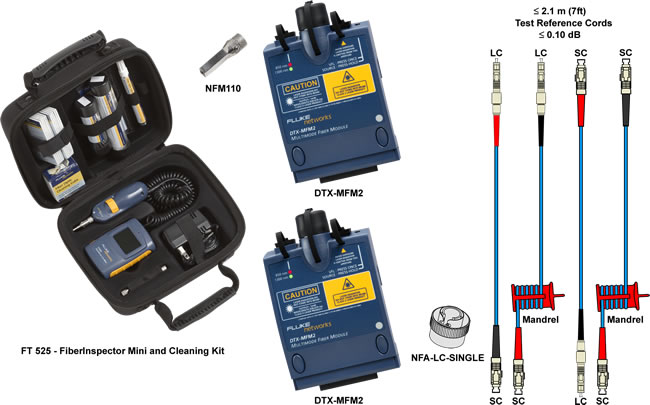
Reinigung ist äußerst wichtig. It is the single most reason for ending up with negative loss values. You cannot clean without some means of visually inspecting the end face. This can be anything from a simple Fiber Viewer to a Video Scope such as the FiberInspector Mini shown above. If you have no inspection device, you cannot proceed. Let's define what is acceptable and not acceptable.
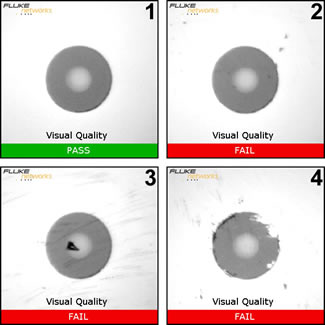 |
|
The Test Reference Cords (TRCs) are critical to a successful measurement. Your multimode TRCs loss should not exceed 0,10 dB at each end. And yes, you must inspect and clean these TRCs every time you use them - even new ones out of the bag.
Where did Fluke Networks get that 0,10 dB requirement?
ANSI/TIA-568-C does not specify a maximum loss requirement for TRCs. However, ISO/IEC 14763-3 does and that's where the 0,10 dB for multimode and 0,20 dB for singlemode comes from.
In this example, we're going to test a 100 m (328 ft) duplex 50/125 µm multimode fiber link with LC connectors at one end and SC connectors at the other end to ANSI/TIA-568-C.
Setting up the DTX CableAnalyzer
- With the fiber modules inserted into the DTX CableAnalyzer, power up the main and remote units.
Sources will need at least five minutes to stabilize, longer in colder or hotter environments.
- Replace the SC Adapter on the remote unit with the optional LC Adapter

- Rotate the dial on the DTX CableAnalyzer to SETUP.
- Select Fiber Loss and press ENTER.
- Change the Test Limit to TIA-568-C Multimode.
- Change the Fiber Type to the cable you are testing.
This setting changes the Refractive Index (n) value. The DTX uses n to calculate the length of the fiber. You can manually enter the n values in Tab 3 of the Setup. If you cannot find your cable in the DTX Cable Library, look to the cable vendor's website for their datasheet. Since the TIA-568-C Multimode limit is calculated based on length, it is important to get this value right.
- The Number of Adapters is going to be 2.
This is always the number of adapters per fiber strand added after the reference has been set.
- Set the Connector Type to LC.
This will not affect the outcome of the result. It only affects the help screens. If you set it to mixed, the help screens will be incorrect for this setup.
- Set the Test Method to 1 Jumper.
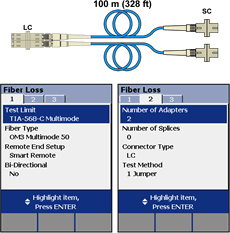
- Clean AND inspect the TRCs.
- Connect the main and remote units together as shown below.
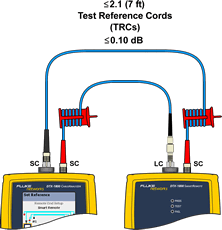
Mandrels must be used. It is a requirement of ANSI/TIA-568-C. Failure to do so can result in good fiber links failing. Red and grey mandrels are shipped with the fiber modules from Fluke Networks. The red is for 50/125 µm and the grey is for 62,5/125 µm TRCs.
- Rotate the dial to SPECIAL FUNCTIONS.
- With Set Reference selected, press ENTER then TEST.
- You will then be presented with the results of the Reference.
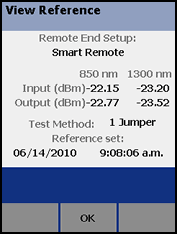
For 50/125 µm it should be better than -24,50 dBm where -23,50 dBm is better than -24,50 dBm.
For 62,5/125 µm it should be better than -20,00 dBm where -19,50 dBm is better than -20,00 dBm.
These values reflect the cleanliness of the Ports and TRCs. The fact that your reference values are better than the minimum stated above does not mean they are good/clean.
- Press F2 OK.
- You can enter the length of your TRCs here. It does not affect the outcome of the test, but will be displayed on the test report.
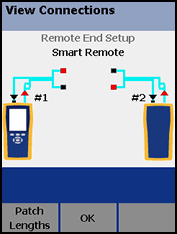
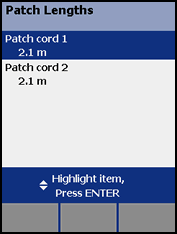
- Press F2 OK when done.
- Remove the SC and LC connectors from the Input Ports and put the dust caps back on them.
Never disconnect from the Output Ports. Doing so invalidates the reference you just set.
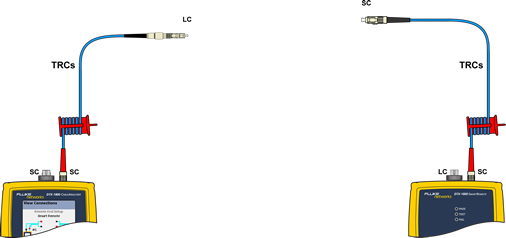
- Insert one of the SC to LC TRC's into the Input Port on the main unit.
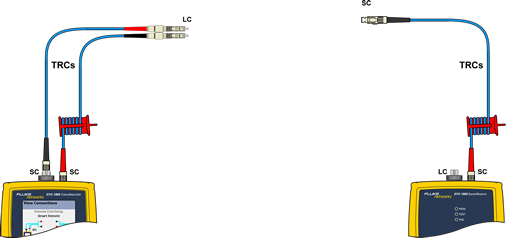
- Insert the other SC to LC TRC into the Input Port on the remote unit.
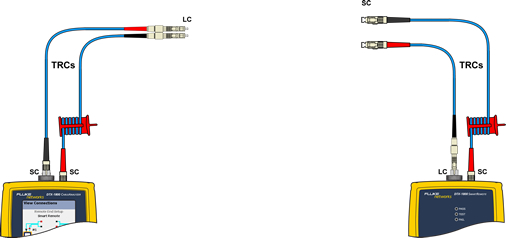
- Place dust caps on the remote TRCs if it is more than a short walk to the other end. According to the EPA, dust in an office can be anything from 2,5 µm to 10 µm so protecting the end faces is critical.
- Connect the TRCs to the link you're testing.
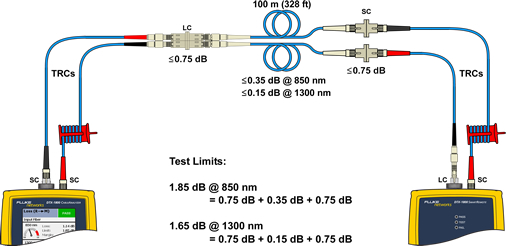
- Press TEST.
How often should I Set Reference?
The quick answer is; every time you begin to test a series of fiber links. It is critical to continually inspect the TRCs.




